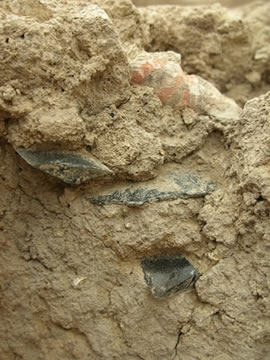CHIPPED STONE
Tristan Carter, Nurcan Kayacan and Marina Milić
Work on the material from the 4040 Area focused entirely on chipped stone assemblages from secure Neolithic contexts, although excavation of later/disturbed contexts invariably produced some objects of note (as with last year’s mirror from a Roman grave fill). This year’s star find was a beautiful bullet-shaped prismatic pressure-flaked blade-core from a mixed, near-surface deposit of Neolithic and Roman material. Near complete, with only its platform removed (as a core tablet for purposes of rejuvenation), the nucleus had been worked around its entire circumference with 12 blade scars visible (12357.X2).

Figure 35. An interesting cache of artefacts was found in a small pit or backfilled post hole (11618) cutting the edge of platform F.1321 in Building 44, South Area. It contained several obsidian fragments along with painted shell. |
The South Area excavation produced 792 pieces of obsidian and ‘flint’ from 155 excavated units that contained chipped stone. 496 of the artefacts came from Building 44 and 296 from Building 56. Only a limited amount of work was undertaken on Building 42 and the underlying deposits as this part of the site was seen to have suffered greatly from post-Neolithic animal disturbance that had served to mix the deposits by introducing later material, including Byzantine pottery.
Initial observations in the IST Area on the chipped stone industry show that the excavated area could be dated back to levels later than Level VI. The raw material used in the chipped stone industry consists of obsidian and flint, with the former used more intensively. Macroscopic examination of the obsidian suggests that it was brought to the settlement from various sources, including not only Cappadocian material, but also Eastern Anatolian.
Team Poznan [TP] excavations generated 959 pieces of chipped stone from a range of contexts, not all of them Neolithic of which 931 were obsidian and 28 ‘flint’, the latter mainly in the form of tan/brown limnic-quartzites. This season’s work provided us with our first assemblages of Level I and II date. Most of this material came from secondary contexts, specifically dump, midden and infill deposits, all of which produced much the same kind of assemblage in terms of relative density of finds.